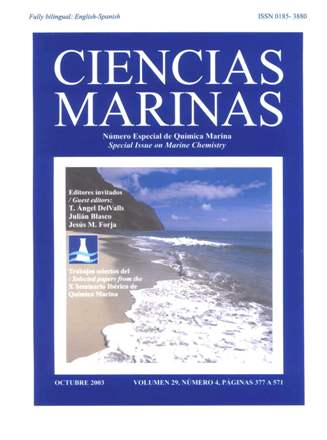Presence, distribution and contamination levels of lead in the surface sediments of the Ria of Ferrol (NW Spain)
Main Article Content
Abstract
This article discuss, using sediment samples from the Ria of Ferrol, the need for a better understanding of the biogeochemical cycle of lead in the Galician rias which, until now, was based on differing methodologies mainly applied to the biota in only few areas of the most important rias from a socio-economic point of view. Thirty-five samples of superficial sediment were analysed for lead (in the < 63 ∞m and total fractions) and opal percentage and organic carbon in the total. An analytical method is proposed employing ETAAS, whereby the sediment is introduced directly as a slurry together with the optimised amount of chemical modifiers. The accuracy of the method was checked by means of a certified reference material, obtaining a sensitivity of 2.72 ∞g g–1 Pb with an RSD of 5.9%. Values of lead in the superficial sediment of the Ria of Ferrol ranged from 13.5 to 159.1 ∞g g–1 for the fraction < 63 ∞m, and from 12.1 to 142.5 ∞g g–1 for the total fraction. The distribution does not follow a decreasing trend from the innermost part of the ria, as may have been expected, but rather the maximum values were found in the vicinity of the harbour area in the middle ria, indicating that rias behave as a lead deposition barrier avoiding the export of the metal to the open sea. Lead dispersion is mainly controlled by the tidal currents, given its lowest concentrations in the zones of strongest current, and also by the plankton, following the relationship obtained [Pb] = 48 [opal] + 16. A baseline lead concentration of 18.2 ∞g g–1 was obtained for the fraction < 63 ∞m using core samples dated at 3745 ± 70 years before present. Applying this background values, the lead enrichment in the Ria of Ferrol is classified from moderate to considerable.
Downloads
Article Details
This is an open access article distributed under a Creative Commons Attribution 4.0 License, which allows you to share and adapt the work, as long as you give appropriate credit to the original author(s) and the source, provide a link to the Creative Commons license, and indicate if changes were made. Figures, tables and other elements in the article are included in the article’s CC BY 4.0 license, unless otherwise indicated. The journal title is protected by copyrights and not subject to this license. Full license deed can be viewed here.

